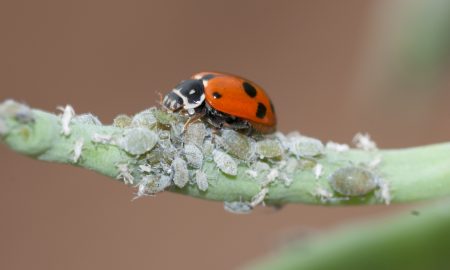Russian wheat aphid reports
Russian wheat aphid has been observed a little further north than last year.
Patches of Russian wheat aphid (RWA, Diuraphis noxia) have been observed in dryland and irrigated wheat, east of Forbes in the Central West Slopes and Plains of NSW. Images from the region show populations of the aphids as well as typical damage symptoms including white stripes and rolled leaves.
Observations of Russian wheat aphid as far north as 20 km from Lark Cargelligo have also been reported, as well as an observation of leaf streaking in a trial near Condobolin.
Prior to these recent reports, the recorded northern-most point of Russian wheat aphid establishment was in the Rankin Springs region of the NSW Riverina.
While Russian wheat aphid has already been declared established in NSW and is no longer a notifiable pest, the NSW Department of Primary Industries and cesar are interested in hearing about incidences in previously unreported areas. We encourage growers or advisers who suspect Russian wheat aphid is present in cereal crops in previously unreported areas to contact us or NSW Department of Primary Industries Biosecurity Officer, Rachel Taylor-Hukins (0409 945 069, rachel.taylor-hukins@dpi.nsw.gov.au).
Rose-grain aphid also spotted
cesar researcher Dr. Elia Pirtle has recently begun fieldwork investigating the relationship between summer conditions in cereal-growing regions and Russian wheat aphid activity.
This work is being undertaken as a part of the GRDC Investment ‘Russian wheat aphid risk assessment and regional thresholds’, which also involves the South Australian Research & Development Institute (SARDI) as a project partner.
In a recent monitoring exercise of roadside grass weeds in Northern Victoria, Dr. Pirtle has observed the rose-grain aphid (Metopolophium dirhodum) as well as Russian wheat aphid.
We also suspect that the rose-grain aphid has been seen inhabiting a crop of durum wheat in the NSW Riverina.
Identification: Russian wheat aphid vs. rose-grain
Rose-grain aphid is a less common cereal aphid and is the aphid species most likely to be confused with Russian wheat aphid.
While Russian wheat aphid and rose-grain aphid are both pale green and spindle-shaped, the rose-grain aphid has:
- A dark green line down the middle of its back
- Larger siphuncles (‘exhaust’ pipes)
- Long antennae
In contrast, Russian wheat aphid:
- Is uniform in colour
- Lacks siphuncles that are visible to the naked eye
- Has short antennae.
Feeding by rose-grain aphid will not cause the classic Russian wheat aphid damage symptoms.


Acknowledgements
Field observations
Adam Dellwo, Elders (Deniliquin, NSW)
Barry Haskins, Ag grow Agronomy & Research (Riverina, NSW)
Helen McMillan, Central West Farming Systems (Central West Slopes & Plains, NSW)
Maarten Van Helden, Entomologist (PIRSA-SARDI)
Tim Wright, AGnVET services (Central West Slopes & Plains, NSW)
Cover image: Photo by Andrew Weeks, Cesar Australia





